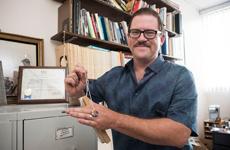October 9, 2018

An international team of archaeologists, including California State University, Northridge anthropology professor Matthew Des Lauriers, received a grant from National Geographic for efforts in unearthing evidence that dates the arrival of Ancestral Native Americans to at least 13,000 years ago, off the coast of Baja California, Mexico.
Des Lauriers’ team of archaeologists includes Oregon State University professor Loren Davis, who received the grant with Des Lauriers to continue investigations that started in 2000. What began as Des Lauriers’ dissertation research is now providing insight into an area locals call “El Piedron” (The Rock), formally known as Cedros Island, on the Pacific coast of Baja California, Mexico.
“From the time I started my undergrad education at Cal State Bakersfield, where I began my training as a California archaeologist,” said Des Lauriers, “I always wanted to do something new that had not been done before. I really wanted to push that boundary.”
Des Lauriers’ work reveals that the early Cedros Islanders harvested resources that were only available by traveling well offshore in watercraft. This provides support for the recent scientific theory that the ancestors of today’s Native Americans arrived from Northeast Asia, traveling along the Pacific coast, as opposed to a route along the east side of the Rocky Mountains. Both alternatives run through or along the massive 1,000-mile-wide land bridge that connected the Chukotka Peninsula in Russia to the peninsula of Alaska during the last Ice Age.
Read the rest of the story at CSUN Today!
